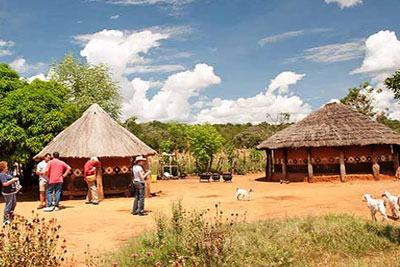Traditional Village Tour
FACTS
ABOUT
AFRICAN CULTURE
Our culture provides us with an ethos we must honor in both thought and practice. By ethos, we mean a people’s self-understanding as well as its self-presentation in the world through its thought and practice in the other six areas of culture. It is, above all, a cultural challenge. For culture is here defined as the totality of thought and practice by which a people creates itself, celebrates, sustains and develops itself and introduces itself to history and humanity
MONDE VILLAGE, VICTORIA FALLS ZIMBABWE
Zimbabwe has 16 official languages, Chewa, Chibarwe, English, Kalanga, “Koisan” (presumably Tsoa), Nambya, Ndau, Ndebele, Shangani, Shona, “sign language” (Zimbabwe Sign Language), Sotho, Tonga, Tswana, Venda, and Xhosa.
DAY 1
Our traditional way of living as Africans still exist in our villages just 20 KM from Victoria Falls town. The villagers’ simple way of living has been a wonder to several thousand tourists who had they are visited there. They live in their outdated thatched huts, they still cook on fire using firewood, and most of their food is produced from their little fields which they cultivate by hand. This is just a hint, book a trip and see for yourself. It will be a three-hour trip.
70 Usd (per person sharing)
- transfer
- water
- guide
Your Content Goes Here
- MINIMUM 2 PAX
- IT CAN START ANY DAY
- VIC FALLS TO MONDE AND RETURN TRANSFER
- IT CAN BE A SHARED TOUR
- TRANSFERS DONE WITH MINI-VANS
- EXPOSURE TO TYPICAL AFRICAN EXPERIENCES
RELATED
DAY TOURS

GUIDED FALLS TOUR
Victoria Falls (Lozi: Mosi-oa-Tunya, “Thundering Smoke”; Tonga: Shungu Namutitima, “Boiling Water”) is a waterfall on the Zambezi River in southern Africa, which provides habitat for several unique species of plants and animals. It is located on the border between Zambia and Zimbabwe and is one of the world’s largest waterfalls, with a width of 1,708 m.

CHOBE DAY TRIP
Road conditions in Chobe National Park depend greatly on the season and rainfall; one needs a 4×4 vehicle to travel in the Park. Thick sand becomes a problem in the Chobe River Front during the dry months, particularly as the temperature rises, while during the wet season the roads near the river become muddy.

HWANGE DAY TRIP
The park is close to the edge of the Kalahari Desert, a region with little water and very sparse, xerophile vegetation. The Kalahari woodland is dominated by Zambezi Teak, Sand Camwood (Baphia) and Kalahari Bauhinia Seasonal wetlands form grasslands in this area. The north and north-west of the park are dominated by mopane woodland. Although it has been argued that elephant populations cause change in vegetation structure, some recent studies suggest that this is not the case, even with the large increases in elephant population recorded in the late 1980s.



